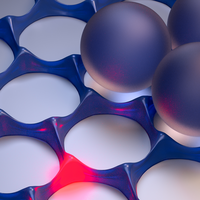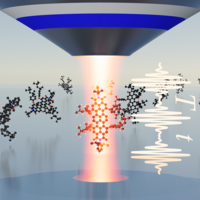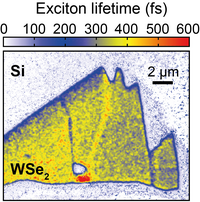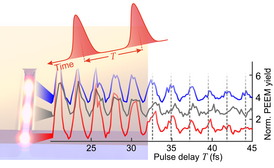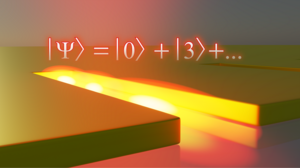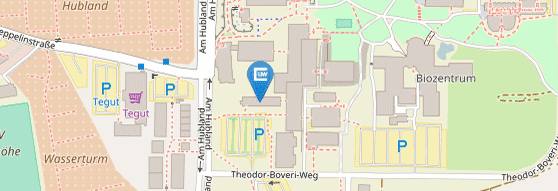Ultrafast micro- and nanospectroscopy
The optical properties and dynamic processes of more or less isolated molecules, as studied in the liquid or gas phase, can be fundamentally changed or even specifically manipulated when these molecules are applied to surfaces or functionalized on nanostructures. In particular, molecular surface systems play an important role in the development of optoelectronic devices, such as smartphone displays and photovoltaic modules, due to their flexible structure and low-cost fabrication. The goal of the manipulation is to control the electronic excitation of the molecular system, which in the particle image is called an exciton and carries the electron, which is important for charge transport, for example. By attaching molecules and other quantum systems to special nanostructures, the interaction of light and matter can even be enhanced so that the individual particle excitations of both subsystems, i.e., photon and exciton, "fuse" together to form a new particle, the exciton-polariton. The unification of the characteristic properties of both worlds is not only interesting from a technological point of view, e.g. to distribute electronic excitation at the speed of light in a system, but also on a fundamental level in the context of quantum optics and the related development of quantum technologies on the scale of the individual building blocks of computer chips.
In our research group, we combine the methods we co-developed to study femtosecond time-resolved dynamics of quantum systems, such as pump–probe spectroscopy and 2D spectroscopy, with microscopy methods. The spatial resolution obtained allows us to specifically study the heterogeneity of extended surface systems [1] and even to investigate the quantum dynamics of single molecules on surfaces [2].
We use not only confocal, home-built light microscopes to detect the fluorescence photons emitted by the system after excitation, but also a photoelectron microscope. The use of photoemissive electrons, whose de Broglie wavelength of about one nanometer is orders of magnitude smaller than the optical wavelength of photons, allows us to achieve spatial resolution far beyond the optical diffraction limit, down to ~3 nm. Together with the femtosecond temporal resolution, we can visualize spatial variations in the lifetime of excitonic excitations in 2D optoelectronic materials [3] as well as detect minute temporal variations in the dynamics of the near-field localized at metallic nanoresonators, so-called surface plasmons [4]. In combination with 2D spectroscopy, we were even able to detect a quantum wave packet of these near-field excitations for the first time [5].
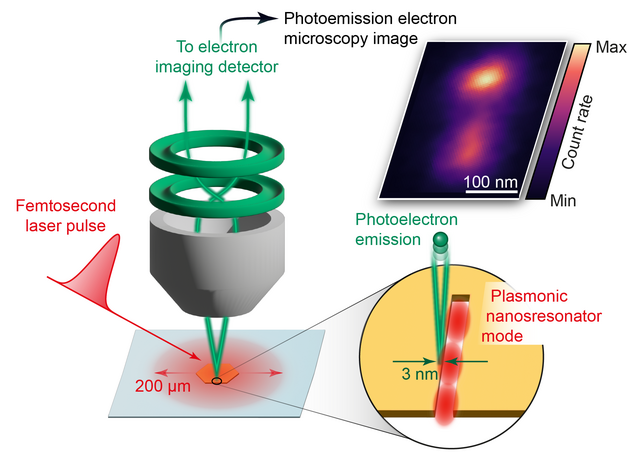
The methods we have developed in this research area aim to gain access to both the spatial and temporal components of the quantum system described by Ψ(r,t) , whether to answer fundamental questions or to support the development of new optoelectronic devices.
References
| [1] | S. Goetz, D. Li, V. Kolb, J. Pflau, and T. Brixner, Here, we combined fluorescence-detected 2D spectroscopy and optical microscopy with high numerical aperture (NA = 1.4) to gain access to the complete single-particle dynamics within submicron regions of a nanostructured polycrystalline thin film of fluorinated zinc phthalocyanine (F16ZnPc). |
| [2] | D. Fersch, P. Malý, J. Rühe, V. Lisinetskii, M. Hensen, F. Würthner, and T. Brixner Single-Molecule Ultrafast Fluorescence-Detected Pump–Probe Microscopy |
| [3] | B. Huber, S. Pres, E. Wittmann, L. Dietrich, J. Lüttig, D. Fersch, E. Krauss, D. Friedrich, J. Kern, V. Lisinetskii, M. Hensen, B. Hecht, R. Bratschitsch, E. Riedle, and T. Brixner, In this publication, we present our setup for time-resolved photoemission electron microscopy with aberration correction, which allows spatial resolution of ~3 nm and temporal resolution below 20 fs. Among other things, we demonstrate the wide-field method on a WSe2 monolayer, where we can use pump-probe spectroscopy to visualize the local lifetime of excited excitons spatially resolved at the nanoscale. |
| [4] | M. Hensen, B. Huber, D. Friedrich, E. Krauss, S. Pres, P. Grimm, D. Fersch, J. Lüttig, V. Lisinetskii, B. Hecht, and T. Brixner, |
| [5] | S. Pres, B. Huber, M. Hensen, D. Fersch, E. Schatz, D. Friedrich, V. Lisinetskii, R. Pompe, B. Hecht, W. Pfeiffer, and T. Brixner, The feature of quantum systems such as molecules and quantum dots is that their state described by the wave function is a superposition state of many possible eigenstates of the system, which can be exploited, for example, in quantum information. In this work, we were able to demonstrate such quantum mechanical superposition states also for surface plasmons, whose near field is moreover localized in a nanoresonator below the optical diffraction limit. |


